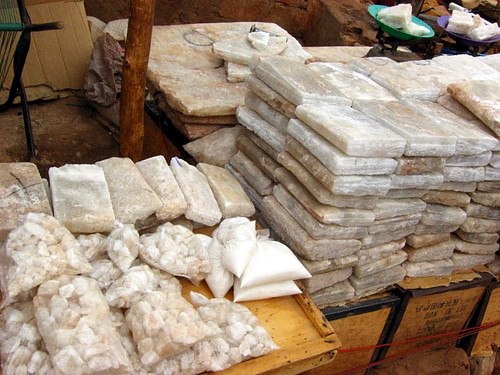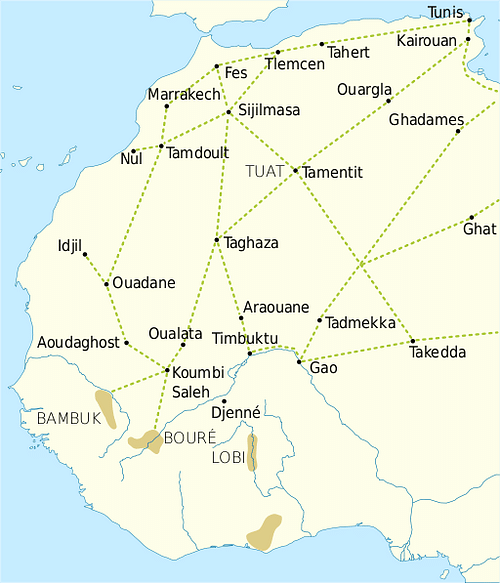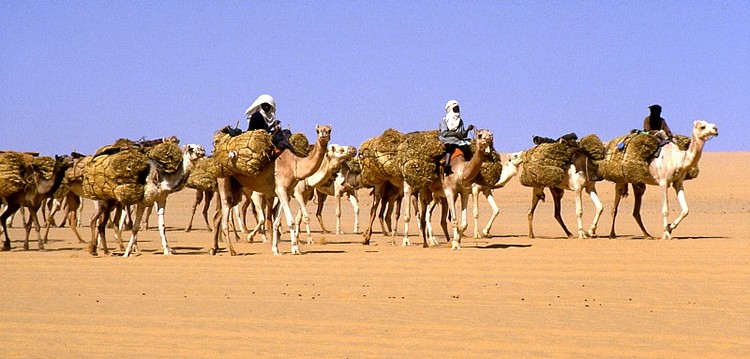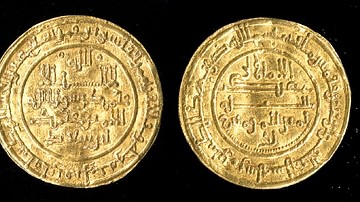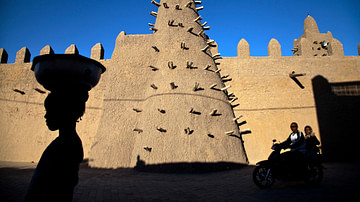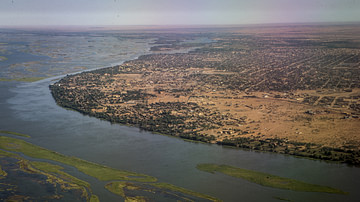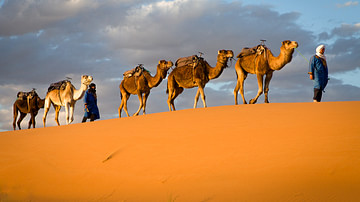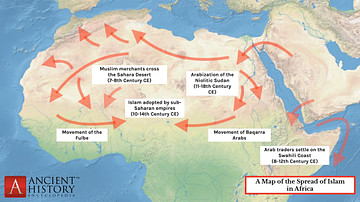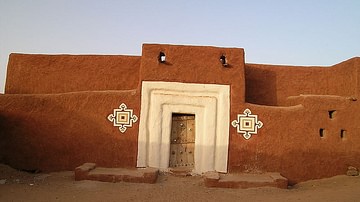Salt from the Sahara desert was one of the major trade goods of ancient West Africa where very little naturally occurring deposits of the mineral could be found. Transported via camel caravans and by boat along such rivers as the Niger and Senegal, salt found its way to trading centres like Koumbi Saleh, Niani, and Timbuktu, where it was either passed further south or exchanged for other goods such as ivory, hides, copper, iron, and cereals. The most common exchange was salt for gold dust that came from the mines of southern West Africa. Indeed, salt was such a precious commodity that it was quite literally worth its weight in gold in some parts of West Africa.
The Salt Mines of the Sahara
The necessity for salt in ancient West Africa is here summarised in an extract from the UNESCO General History of Africa:
Salt is a mineral that was in great demand particularly with the beginning of an agricultural mode of life. Hunters and food-gatherers probably obtained a large amount of their salt intake from the animals they hunted and from fresh plant food. Salt only becomes an essential additive where fresh foods are unobtainable in vey dry areas, where body perspiration is also normally excessive. It becomes extremely desirable, however, amongst societies with relatively restricted diets, as was the case with arable agriculturalists. (Vol II, 384-5)
In addition, salt was always in great demand in order to better preserve dried meat and to give added taste to food. The savannah region south of the western Sahara desert (known as the Sudan region) and the forests of southern West Africa were poor in salt. Those areas near the Atlantic coast could obtain the mineral from evaporation pans or boiling sea water, but sea salt did not travel or keep well. A third alternative was salt derived from the ashes of burnt plants like millet and palms, but again these were not so rich in sodium chloride. Consequently, for most of the Sudan region, salt had to come from the north. The inhospitable Sahara desert was the chief natural source of rock salt, either acquired from surface deposits caused by the desiccation process such as found in old lake beds or extracted from relatively shallow mines where the salt is naturally formed into slabs. This salt, which was a creamy-grey colour, was far superior to the other sources of salt from the sea or certain plants.
When exactly salt became a trade commodity is unknown, but the exchange of salt for cereals dates back to prehistory when desert and savannah peoples each looked to gain what they could not produce themselves. On a larger scale, camel caravans were likely crossing the Sahara from at least the first centuries of the 1st millennium CE. These caravans would be run by the Berbers who acted as middle-men between the North African states and West Africa. Salt was their major trade good but they also brought luxury items like glassware, fine cloth, and manufactured goods. In addition, with these trade goods came the Islamic religion, ideas in art and architecture, and cultural practices.
Salt, both its production and trade, would dominate West African economies throughout the 2nd millennium CE, with sources and trade centres constantly changing hands as empires rose and fell. The salt mines of Idjil in the Sahara were a famous source of the precious commodity for the Ghana Empire (6-13th century CE) and were still going strong in the 15th century CE. In the 10th century CE the Sanhaja Berbers, who controlled the salt mines at Awlil and Taghaza and transportation through trade cities like Audaghost, began to challenge the Ghana Empire's monopoly of the trade. In the 11th century CE the Awlil mines were in the hands of Takrur, but it would be the Mali Empire (1240-1645 CE), with its capital at Niani, that dominated the sub-Saharan salt trade following the collapse of the Ghana Empire. However, semi-independent river 'ports' like Timbuktu began to steal trade opportunities from the Mali kings further west. The next kingdom to dominate the region and the movement of salt was the Songhai Empire (15-16th century CE) with its great trading capital at Gao.
Salt may have been a rarity in the savannah but at desert mining towns like Taghaza (the main Sudan source of salt up to the 16th century CE) and Taoudenni, the commodity was still so abundant slabs of rock salt were used to build homes. Naturally, such a valuable money-spinner as a salt mine attracted competition for ownership, as when the Moroccan leader Muhammad al-Mahdi attempted to muscle in on the market by arranging for several prominent Tuareg salt traders to be murdered at Taghaza in the mid-16th century CE. Quite literally, whoever controlled the salt trade also controlled the gold trade, and both were the principal economic pillars of the various empires of West Africa's history.
The 14th-century CE Muslim traveller Ibn Battuta, who visited West Africa c. 1352 CE, gives a lengthy description of life in the salt mine settlement of Taoudenni:
It is a village with no attractions. A strange thing about it is that its houses and mosques are built of blocks of salt and roofed with camel skins. There are no trees, only sand in which there is a salt mine. They dig the ground and thick slabs are found in it, lying on each other as if they had been cut and stacked under the ground. A camel carries two slabs. The only people living there are the slaves of the Massufa, who dig for the salt.
(quoted in de Villiers, 121-122)
Transportation
The salt slabs, relatively durable but unwieldy, were loaded onto camels, each animal carrying two blocks that weighed up to 90 kilos (200 lbs) each. A camel caravan could be composed of anywhere from 500 to several thousands of camels in their heyday. The first caravans likely crossed the western Sahara in the 3rd century CE, if not earlier, but the practice really took off from the 9th to 12th century CE. When the caravans arrived at a trading centre or major settlement in the Sudan region, the salt was exchanged for goods to carry back across the desert on the return journey; typically such loads included gold, leather, animal skins, and ivory. The salt could be used in the communities around the trading centres or simply transported on by boat along such rivers as the Niger, the Senegal, and their tributaries. Finally, the salt was cut up into smaller pieces and porters carried it on their heads to its final destination - the villages of West Africa's interior.
Worth its Weight in Gold
Salt was a highly valued commodity not only because it was unobtainable in the sub-Saharan region but because it was constantly consumed and supply never quite met the total demand. There was also the problem that such a bulky item cost more to transport in significant quantities, which only added to its high price. Consequently, salt was very often exchanged for gold dust, sometimes even pound for pound in remote areas, with merchants specialising in one of the commodities. Indeed, such was the stability of the mineral's value, in some rural areas small pieces of salt were used as a currency in trade transactions and the kings of Ghana kept stockpiles of salt alongside the gold nuggets that filled their impressive royal treasury. The passage of such a valuable item from one trader to another provided ample opportunity to increase its value the further it went from its source in the Sahara.
An anonymous Arab traveller of the 10th century CE recorded the delicate operation of bulk trading between salt and gold merchants, sometimes called 'the silent trade' where neither party actually met face to face:
Great people of the Sudan lived in Ghana. They had traced a boundary which no one who sets out to them ever crosses. When the merchants reach this boundary, they place their wares and cloth on the ground and then depart, and so the people of the Sudan come bearing gold which they leave beside the merchandise and then depart. The owners of the merchandise then return, and if they were satisfied with what they had found, they take it. If not, they go away again, and the people of the Sudan return and add to the price until the bargain is concluded.
(quoted in Spielvogel, 229)
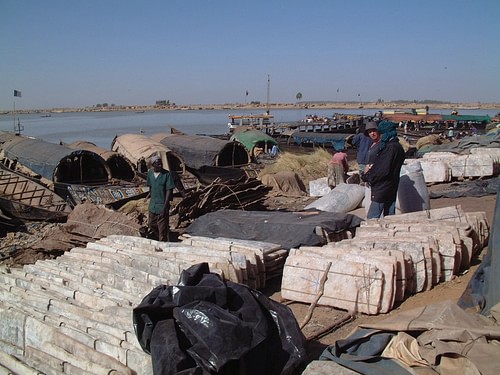
Even the passage through of salt could be a lucrative source of income for rulers. For example, the Arab traveller Al-Bakri, visiting the Sudan region in 1076 CE, describes the duties on salt in the Ghana Empire which were, unlike with other goods like copper, taxed twice: "On every donkey-load of salt the King of Ghana levys one golden dinar when it is brought into his country and two dinars when it is sent out" (quoted in Fage, 670). In another example, Timbuktu operated as the middle-trader in this exchange of northern and West African resources. A 90-kilo block of salt, transported by river from Timbuktu to Djenne (aka Jenne) in the south could double its value and be worth around 450 grams of gold. As the Tarikh al-Sudan chronicle, compiled c. 1656 CE, notes:
Jenne is one of the greatest Muslim markets, where traders carrying salt from the mines of Taghaza meet traders with the gold of Bitou…It is because of this blessed town that caravans come to Timbuktu from all points of the horizon.
(quoted in Oliver, 374)
Even today, the salt trade continues, although the deposits are running out and the salt merchants can no longer command gold dust in exchange. Saharan salt from Taoudenni is still transported by Tuareg camel caravans, the still-90-kilo slabs now ultimately destined for the refineries of Bamako in Mali.
